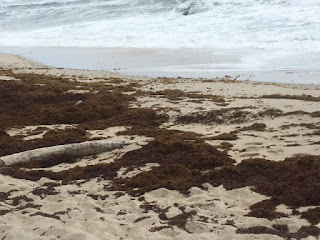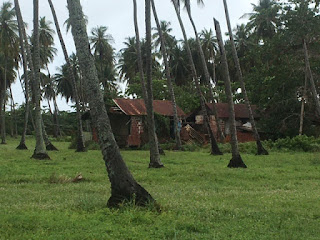Zorina Shah
Chaguanas, near Sasenarine gas station, is perhaps not the best place to be at 6.30 a.m. I stood under the eave of a house where a girl in my high school class once lived. The motorbike cop made a few turns but it seemed as if even he conceded defeat in the traffic chaos. Claire Watson couldn’t have rescued me soon enough and we headed through some back roads, avoiding the Uriah Butler Highway traffic to get to Sangre Grande.
I had once moonlighted in ‘Grande’ for a few months, Allison had taught at a high school there and Claire, well let us not put anything past her. We changed cars at her sister Wendy’s house and we were in a hurry to leave the hub for the coast. I like to rattle off the names of the villages - Oropouche, Matura, Salybia, Rampanalgas, Balandra, Cumana, Toco, Mission, L’Anse Noire, Sans Souci, Monte Video, Grande Riviere, St. Helena and Matelot.
Yes Matelot!
The village no longer held the magic as it did for me all those years ago. Approaching Easter, the mountains would be coloured yellow and red, purple, tangerine and a dozen shades of green. Today a dark foreboding colour posed no competition against the Caribbean sea, itself struggling to capture its poeticised beauty. The Catholic Church at the point where the Paria Main Road is broken, up to Blanchisseuse, is no longer there, the site cleared for construction. We didn’t have to walk along ‘below road’ and cross a rickety wooden bridge to go to the high school. I pictured infants diving from those planks into the river below, a common sight for decades. Now, no more! One can drive straight across the new bridge with its 1.5 ton limit. I called out to Monty's father, Mr. Alston Zoe as we passed, spoke to Hyacinth Cummings nephew and on the way out stopped by a house owned by Dennis Lau’s family where I met Reuben Garcia.
If it looks like I am telling the story backwards, I am not. I just wanted to get that Matelot blues off my chest.
 |
| Street named after Sr. Rosario in Matelot |
Claire was not driving, so the road was not exactly straight, the wheels of the car and the potholes formed a strange but steady relationship and a left turn at a critical juncture was taking us back to Valencia instead of our destination.
Between Matura and Toco, large sections of the coast are taken up by holiday homes and private resorts. With that and the Covid restrictions, there were few opportunities to walk on the beach, so we grabbed what we could. One was a semi-resort, fishing port in Salybia. The rain that follows Claire and Allison had not yet shown up. There was no one to talk to and we were the sole proprietors for that while, of all that we surveyed. When we passed back in the afternoon we saw that there were numerous new owners.
 |
| Proud owners of everything on Salybia Beach |
 |
| Teachers with Antourage... |
We drove up the incline to another and were told that it was owned by a family and no longer accessible by the public. Claire and Allison thought the guy we spoke to was a guard but I am thinking he is a member of the family. What struck me is that he is of East Indian descent. On those parts of the road to Matelot, there is very little sign of ‘Indian people’. I had never seen a Hindu temple or a mosque in all the years I travelled those roads, but this day, there was a mosque just before Cumana, what looks like a relatively new building. It occurred to me that there was spread of the religion among young people of African descent in the community.
The small section of the beach before Cumana looked inviting but smelled fishy, bad fishy. They thought it might be rotting sargassum. As lovely as the Atlantic was, we also had good reason for a quick departure.
 |
| Sargassum weed |
The road to Cumana was quiet except for the Electricity truck. The driver clearly did not know the corners and made a good attempt at overturning. Cumana Junction itself provided the first busy area with its gas station and lots of shops. At Toco we turned into the lighthouse road hoping to find a good view of where the Atlantic meets the Caribbean Sea. The area was closed off for construction and the contractor's guy proudly told us that when it reopens there will be bathrooms for which we will have to pay. The little stretch to the lighthouse looked desolate, very little activity, an indication of how Covid-19 has changed life for many.
 |
| Near the Lighthouse |
Our next stop was Mission Village where I hoped Claire would get a chance to see her friend. Instead as we pulled up she spotted the son Kwesi Alleyne, the Catholic priest for the coast. I was thinking it is still one priest but my friend Gail Coutain has told me there is a cluster from Cumana to Matelot with an additional priest, Fr. Raymond Francis.
 |
| Looks like someone is having a chat with God about the pandemic! |
The surf at Sans Souci is usually a sight to behold, but we caught it on the moderate side. Lower down at Grande Riviere, where the turtles come in to nest, it was also quiet. Albert Nixon, who owned the shops in Toco and Grande Riviere had delivered grocery orders to customers down the coast. He has converted one shop to apartments, a sign of the changing economic activity on the coast. No private property blocked out the Caribbean Sea. We were given a full view in the distance, some places bright shades of blue and green, slightly more subdued in others.
We had lunch on the way back at Acajou resort, a place where Claire had stayed before. Their Christian instincts must have dictated that they eat fish, but I was not so hampered even on Jumaah Friday. I had grilled chicken with fries, or ‘chips’, a word which became the focus of a long discussion.
The drive back was relaxing. I ignored most of the potholes and their conversation and enjoyed the scenery. In the middle of Sangre Grande, Allison sent me out to collect an item for her. I first entered the wrong mall at Plaza Grande, then the right one and walked right past the store to the back of the building.
We changed cars again and Allison went her way while Claire and I used the traffic all through Cunupia and Enterprise to talk. On the last two trips, I had been first to be home, this time around I didn’t make it until 7.30 p.m.


















